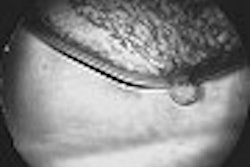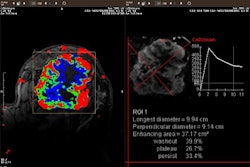In today’s editorial, AuntMinnie founder and practicing radiologist Dr. Phillip Berman offers some facts and opinions on addressing the mammography crisis. Below, AuntMinnie members respond to the editorial, and offer their own take on the current quandary in breast imaging.
Dr. Larry L. Cohen of Santa Fe, NM:Well vented, but you are preaching to the congregation/believers...this article (is) for our lawmakers. They are the people with the deaf ears.
Dr. Mark E. Klein of Washington Radiology Associates in Washington, DC:
Although your intentions are laudable and you have many good ideas with which I agree, I believe you have missed one salient point. I refer you to an article by Dr. Warren Burhenne (and co-authors) in Radiology, which discusses the use of computer-aided detection (CAD) and an analysis of miss rates in mammography (May 2000, Vol. 215:2, pp. 554-562).
Just about every well-respected mammographer is in that paper. That multicenter study documented a retrospective visibility rate of 67% for mammographically detected breast cancer. More important, the outright miss rate by good mammographers was 21%, not the 7%-10% you ascribe in your editorial. This is a huge number, and indicates a limitation of the existing technology, or in your vernacular the "imaging chain."
Even with the best mammographers reading mammograms, the miss rate will be high. Actually, the 80% sensitivity rate you dismiss is as good as it currently gets. But even with this miss rate mammography does save lives.
Women's access to mammography is becoming more limited due to high malpractice risk and low reimbursement. Suing radiologists for failure to diagnose breast cancer is now the number one medical malpractice litigation issue in the U.S.
Since a no-fault program is not likely to be achieved in the current political climate, we need to make some effort to diminish the risk to mammographers who, as you correctly stated, are doing a public service. We need to effectively reverse the concept of the standard of care in mammography. With the known miss rate of 21% by excellent mammographers, the question should not be whether a good mammographer should have seen the finding, but whether a good mammographer could have missed the finding. I agree that additional certification and credentialing is necessary for mammographers, but until the technology sufficiently changes, the miss rate will remain significant.
Radiologists need to close ranks and aggressively address the issues in mammography you listed in your editorial. While we may disagree on specifics, we can agree that this is a problem that must be fixed if we are to continue providing this service to women. Step one must be to attempt to curtail expert plaintiff testimony by radiologists who are helping to fuel the lunacy in mammography malpractice cases.
Radiologists must insist that meeting planners require disclosure from prospective speakers concerning their personal history of testifying for plaintiffs, and to make this available to prospective attendees. It is the greatest insult for a radiologist to pay to hear a lecture, and then a year later have that lecturer show up on the other side of the table as an expert for the plaintiff.
Dr. Stu Masters of Pittsfield, MA:The public, with much guidance, needs to agree to a level of sensitivity and accuracy that it will accept. Radiologists should maintain their own, and group, statistics as a guideline to quality.
Reimbursements and risk of malpractice, like it or not, will ultimately determine whether tomorrow's radiologists learn and provide mammography in their practice. Today's radiologists will be retiring, or cutting back, or simply omitting mammography from their practice as the climate worsens.
I would add a significant step between an individual learning that his/her sensitivity and accuracy are below standards and simply discontinuing mammography interpretation. Radiologists are educable. Some who fall below stated guidelines may wish to get additional training to upgrade their skills. More than a few radiologists still practice out of a sense of doing good for our patients. And I believe that mammography is still the gold standard for detection of breast cancer.
Dr. Ronald Nicol:Our group is having trouble finding new people who are willing to read mammo other than the two fellowship-trained mammographers we already have. I anticipate having to strongly consider not providing mammography services in the future as the older members retire.
We are a group of more than 20 radiologists, and if we face this problem, others must also. Does the government wish to have nobody willing to read mammo in the future? Do they realize that few people want to do this anymore given the legal risk, low reimbursement, and multiple regulation requirements?
Anonymous:
Excellent points!
I am a fellowship-trained mammography reader, and I currently read over 5,000 mammos a year. I have had years that I have read over 10,000 mammos. When I do my personal audit, I calculate my sensitivity, specificity, positive predictive value, number of cancers per 1,000 found, average size and stage of cancers found, and callback rates (among other statistics).
I also calculate those of my partners that read mammography, as a matter of course, being the lead mammographer and director of the women's imaging center. The results are sometimes a bit shocking to the other members of the women's imaging team. I have had many radiologists voluntarily drop out of the mammo circuit after they receive their audit.
Unfortunately it is not only the sensitivity that counts; in fact sensitivity is quite a difficult statistic to interpret. We are better off looking at the positive predictive values, an indicator of the number of times that you are correct when labeling a case "suspicious, or highly suspicious."
This, in conjunction with the number of cancers per 1,000 that you detect per year, compared to your colleagues’ numbers, will give you an idea of the accuracy of your readings. As long as your positive predictive value is above about 25%, and your cancer detection rate is roughly equivalent to your best mammo reader, then you are doing fine.
Of course, the callback rates and average size and stage of the cancers you detect is important also. One, because the practicality of running a mammo department precludes a high callback rate (>10%) due to the cost to both your staff and the patients involved. The other, because if you are only detecting stage III cancers, there is a problem with your technique.
In an FDA-approved mammography department, an audit should be generated every year... a careful double-checked audit, with outstanding cases, and false-negative cases pulled for the review of the doctors involved.
If this is done, then there is no need to force anyone out of the field, they will voluntarily resign, I promise you. Most general radiologists that read mammography find it their least-favorite specialty.
Anonymous:Very interesting. Don't think bad mammographers would ever admit they are bad and retire themselves. Chances are that (they) are bad radiologists all together and may have to retire from the radiology in general. Let them pay for their mistakes in court. This will sort them out.
Radiologic technologist Mary Jo Zito of Temple, TX:The FDA’s Mammography Quality Standards Act (MQSA) Web site is invaluable at finding facilities that do mammography; however, it would be so much more productive if (a facility’s) fax number were given to facilitate film transfer. I would prefer that the fax number instead of the phone number be listed. In the same vein, the fax number should be included in the outgoing message on every facility's phone mail to facilitate film transfer.
Radiologic technologist Jeralynn Scott:I have been a mammographer for 10 years, and witness daily the increasing need for services to women who have no idea how to educate themselves to know what a quality mammogram is. MQSA standards are well recognized, but they too are flawed in many aspects.
A 40-hour training period does not prepare mammographers for what they are in store for. The key is not just producing a film. It is caring that the films you are producing have the quality for a radiologist to make a diagnosis that is as close to 100% (as possible) the first time.
Now (the government) is thinking of setting a number a screening center must do to assure quality. As numbers go up, something has to be lost because reimbursement is so ridiculous. Can you guess what (will be lost)? Quality. The mammographers will have less time to do the 20-point check: Is there motion?, enough pec.?, nipple in profile?, etc.
My job is the greatest job when I am allowed to do it well. The bottom line is that MQSA is a wonderful tool for mammography and is highly needed, but don’t sacrifice the rules and think you are creating quality. You are not. You are substandardizing what MQSA was really intended to be.
Dr. Frank Simone of Indiana, PA:
As a "B" reader for pneumoconiosis since 1987, I have had to face the recertification exam for (National Institute for Occupational Safety and Health, NIOSH) every four years. It involves a trip to Morgantown, WV, to interpret 60 chest films for pneumoconiosis.
A certain minimum score is needed to retain certification. A similar mechanism could be argued for mammography, but the reimbursement and litigation atmosphere must be improved to a significant degree before I would subject myself to the hassle and stress of recurring testing.
The insurers or the government -- and not the radiologists undergoing the testing -- should pay the cost of administering the process, if such a system were adopted.
Related Reading
Making mammographers better: The last link in the imaging chain, August 29, 2003
Radiology residents not interested in reading mammograms, June 9, 2003
Driving improvement without driving the docs away: rethinking the MQSA, May 27, 2003
Radiologists say training, not tests, will hone mammography skills, April 10, 2003
Lawmakers mull mandatory testing of radiologists' skills in reading mammograms, April 8, 2003
Copyright © 2003 AuntMinnie.com



















